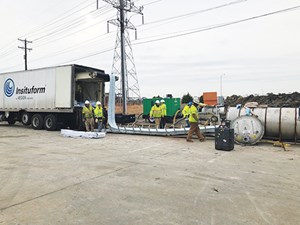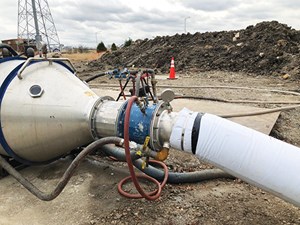July 2023 Vol. 78 No. 7
Features
Rehab Technology: Emergency repair of unexpected leak
Tim Peterie and Steve Soldati, P.E.
(UI) — Created in 1951, by the Texas Legislature, North Texas Municipal Water District (NTMWD) consists of 10 original member cities, including Farmersville, Forney, Garland, McKinney, Mesquite, Plano, Princeton, Rockwall, Royse City and Wylie. By 1956, this new agency was providing water to the region.
By the 1970s, the district expanded its service to wastewater systems and added three new member cities, including Richardson, Allen and Frisco, between 1971 and 2001. With an ever-expanding region for NTMWD to operate and maintain, it was paramount for its leadership to find innovative methods to maintain its water and wastewater system and keep up with demand.
By the numbers, NTMWD serves up to 80 communities/water authorities covering approximately 2,000 square miles in 10 counties. Two million people live within 80 District communities that make up one of the fastest-growing regions in the United States.
There are 18 major raw and treated water pump stations, six water treatment plants, over 610 miles of water transmission pipelines, over 226 miles of large-diameter wastewater pipelines, 13 wastewater treatment plants, and a total capacity of over 163 MGD of wastewater treatment.
NTMWD provides high-quality and dependable water, wastewater and solid waste services in a cost-efficient manner with four main goals: service, stewardship, partnership, and people. These goals drive the day-to-day operations and influence NTMWD’s approach to improving and maintaining the extensive system.
Water and wastewater municipalities and agencies develop capital improvement programs to enhance or expand their infrastructure system. This is the more structured method of properly evaluating the system improvement needs and the available funding. However, the infrastructure that municipalities operate and maintain does not wait for a capital improvement program to be developed before it decides to fail.
The nation’s infrastructure deteriorates at different rates, depending on several factors, and it is difficult to determine the exact time when a pipeline is going to fail. Responding with all the proper information and tools at hand is critical to responding most efficiently and effectively.
Surprise
This was the case with a lift station and force main in the city of Plano, Texas. The Lower White Rock Creek Lift Station collects wastewater from the surrounding area and pumps the raw sewage through approximately 27,000 linear feet (LF) of sewer force main with varying diameters from 16 inches to 27 inches. The force main begins as a 16-inch diameter pipeline at the Lower White Rock Creek Lift Station and, along the way to the final discharge vault, upsizes in diameter as it accommodates seven interconnects.
Approximately 12,700 LF of 16-inch force main was constructed in 1978 and, due to the area’s growth over the years, the 24-inch and 27-inch diameter extension was constructed in 1989. The most recent addition was an 18-inch force main pipeline constructed in 2009 to interconnect into the 24-inch pipeline just before the upsize to the 27-inch diameter section.
In August of 2018, a leak was discovered by Plano in a storm drain located under the 16-inch force main. The issue was a fascinating discovery due to the rare circumstances – one pipe’s leak was being captured by another pipe.
This is an important lesson when inspecting portions of infrastructure: you never know what you will find that is not related to the focus of the intended inspection. In addition, sometimes the location where the leak surfaces is not where the leak actually occurs. When a pipeline has a leak, depending on the topography, soil conditions and other adjacent infrastructure features, it can begin to show itself in another location that is not as intuitive.
For a sanitary sewer overflow (SSO) situation, as was the case here, the first priority is to mitigate the leak and provide a temporary repair to stop further leaking. With this repair in place, a team of engineers and operators can then begin the design and implementation of a long-term solution.
Once the leak location was determined and accessed, crews set up a stilling well and pumped the leaking fluid to a nearby manhole. The use of pump trucks and sump pumps facilitated the transfer of this fluid to the manhole to evacuate the leaking sewer effluent.
When addressing an isolated failure location, all focus and resources go to mitigating the issue. There is one main goal: stop the leak. However, when looking at a larger, long-term solution, there are several factors that need to be considered, such as maintenance of traffic flows, community disruption, temporary flow bypass and excavation access points.
These factors are typically reviewed and evaluated through the planning and design phases to ensure that the proper rehabilitation technique is chosen for the intended application. This was the case for this project where, given the design criteria and site layout, cured-in-place pipe (CIPP) was the most cost-effective, best-fit solution to fully restore this failing segment.
CIPP is engineered and manufactured to project specifications and is designed as an independent solution to meet the pipe rehabilitation goals. This pipe-within-a-pipe method can rehabilitate almost any pipeline between 6- and 96-inch diameter and is a fully structural AWWA Class IV solution, meaning there is no reliance on the existing host pipe for the new service life.
CIPP can be installed up to several hundred feet at one time and does not hinder the flow capacities of the pipelines. With only two small excavation pits on either end of the pressure CIPP installation, and the ability to bypass or reroute the flow, the rest of the facility operations above the pipeline will not be disrupted during the rehabilitation process.
Solution
For this 16-inch emergency force main repair, Insituform’s pressure-rated CIPP, InsituMain, was installed to fully restore the failing segment of the pipeline. InsituMain can be manufactured and installed in a wide range of diameters and operating pressures with physical properties exceeding ASTM F1216 and AWWA M28.
NTMWD required a 150-psi pressure-rated lining system. At this pressure rating, the close fitting InsituMain liner had a thickness of just 8.5 mm. With an overall diameter loss of less than 0.67 inches and a Hazen-Williams friction coefficient of at least 140, flow capacities were not jeopardized for this project.
With a lining system that met the technical requirements by NTMWD, the team needed to put the solution into action by accelerating the contracting process. The contract between NTMWD and Insituform was executed on Oct. 31, 2018, just two short months after the leak was first discovered. From the Notice-to-Proceed date in October, the CIPP liner was manufactured, delivered, installed and pressure tested all by Dec. 14, 2018.
To achieve a fully structural Class IV solution, the CIPP solution needed to be properly designed and manufactured to meet the operating conditions of the pipeline from internal pressures and external loading. However, one key aspect to providing a fully structural Class IV solution is to appropriately terminate the liner. This is achieved by terminating the liner into a new end spool piece, where an internal end seal is then installed.
Terminating outside the limits of the existing pipe eliminates reliance on the existing deteriorating host pipe for future service life. When this same termination detail is provided on the other end of the segment to be rehabilitated, standard pipe closure spools and fittings can be installed to reconnect to the existing pipeline prior to backfilling and restoration of the site.
After the CIPP repair was installed, the owner was then able to inspect the remaining force main length to determine the best path forward for future restoration techniques. Using both the PipeDiver and SmartBall by Pure Technologies, the owner was able to collect valuable data on the existing condition of the pipeline to make an informed decision on the best-fit rehabilitation solution.
The condition assessment tools provided results that showed several air and gas pockets, and areas where there was substantial pipe wall loss. These results allowed the owner to plan and design the proper improvements to the system by adding new ARVs in strategic locations and identifying candidates for rehabilitation.
Discovering a leak is never the preferred way of finding out that rehabilitation or repair of a pipeline is necessary. However, the emergency repair and subsequent inspection of this project showcased the versatility and adaptability of the trenchless rehabilitation industry. The industry is technology-based and always working to provide better tools and solutions to address the increasing need for innovative, cost-effective equipment to address aging infrastructure.
With an entire industry dedicated to solving problems that impact every community and a network of owners and engineers matching the available solutions to the problems, we rely on the collaborative approach to find the best fit solution to maintain our critical water and wastewater infrastructure.
ABOUT THE AUTHORS:
Tim Peterie is the Insituform business development manager for North Texas, Oklahoma and Arkansas. Steve Soldati, P.E. is the regional sales manager of pressure pipe for the Eastern United States for Aegion Corporation.







Comments